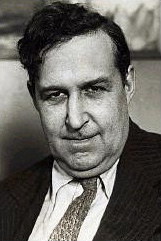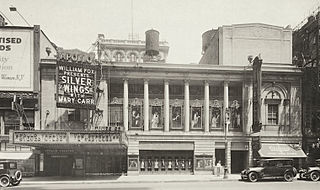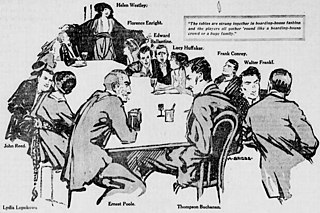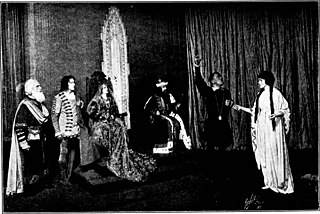
Heywood Campbell Broun Jr. was an American journalist. He worked as a sportswriter, newspaper columnist, and editor in New York City. He founded the American Newspaper Guild, later known as The Newspaper Guild and now as The NewsGuild-CWA. Born in Brooklyn, New York, he is best remembered for his writing on social issues and his championing of the underdog. He believed that journalists could help right wrongs, especially social ills.

The Walter Kerr Theatre, previously the Ritz Theatre, is a Broadway theater at 219 West 48th Street in the Theater District of Midtown Manhattan in New York City. The theater was designed by Herbert J. Krapp and was constructed for the Shubert brothers in 1921. The venue, renamed in 1990 after theatrical critic Walter Kerr, has 975 seats across three levels and is operated by Jujamcyn Theaters. The facade is plainly designed and is made of patterned brick. The auditorium contains Adam-style detailing, two balconies, and murals.

The Booth Theatre is a Broadway theater at 222 West 45th Street in the Theater District of Midtown Manhattan in New York City. Opened in 1913, the theater was designed by Henry Beaumont Herts in the Italian Renaissance style and was built for the Shubert brothers. The venue was originally operated by Winthrop Ames, who named it for 19th-century American actor Edwin Booth. It has 800 seats across two levels and is operated by The Shubert Organization. The facade and parts of the interior are New York City landmarks.

The Times Square Theater is a former Broadway and movie theater at 217 West 42nd Street in the Theater District of Midtown Manhattan in New York City, near Times Square. Built in 1920, it was designed by Eugene De Rosa and developed by brothers Edgar and Archibald Selwyn. The building, which is no longer an active theater, is owned by the city and state governments of New York and leased to New 42nd Street.

The Stephen Sondheim Theatre, formerly Henry Miller's Theatre, is a Broadway theater at 124 West 43rd Street in the Theater District of Midtown Manhattan in New York City. Owned by the Durst Organization and managed by the Roundabout Theatre Company, the modern 1,055-seat theater opened in 2009 at the base of the Bank of America Tower. The current theater is mostly underground and was designed by Cookfox, architects of the Bank of America Tower. It retains the landmarked facade of the original Henry Miller's Theatre, which was built in 1918 by Henry Miller, the actor and producer.

Madge Kennedy was a stage, film and TV actress whose career began as a stage actress in 1912 and flourished in motion pictures during the silent film era. In 1921, journalist Heywood Broun described her as "the best farce actress in New York".

The First Year is a 1932 American pre-Code film based on a 1920 play of the same name that originally ran on Broadway at the Little Theatre. The play was written by Frank Craven and produced by John Golden. It closed in 1922 after 760 performances.

The Washington Square Players (WSP) was a theatre troupe and production company that existed from 1915 to 1918 in Manhattan, New York City. It started as a semi-amateur Little Theatre then matured into a Repertory theatre with its own touring company and drama school. It received national newspaper coverage and sparked like-minded companies across the country. After it ceased operating, three of its members founded the Theatre Guild.
Mary Rose is a play by J. M. Barrie, who is best known for Peter Pan. It was first produced in April 1920 at the Haymarket Theatre, London, with incidental music specially composed by Norman O'Neill. The play was produced in New York that year. Its most recent revival in New York was in 2007 and in London in 2012.

The Bat is a three-act play by Mary Roberts Rinehart and Avery Hopwood that was first produced by Lincoln Wagenhals and Collin Kemper in 1920. The story combines elements of mystery and comedy as Cornelia Van Gorder and guests spend a stormy night at her rented summer home, searching for stolen money they believe is hidden in the house, while they are stalked by a masked criminal known as "the Bat". The Bat's identity is revealed at the end of the final act.

The Blue Flame is a four-act play written by George V. Hobart and John Willard, who revised an earlier version by Leta Vance Nicholson. In 1920, producer Albert H. Woods staged the play on Broadway and on tour across the United States. Ruth Gordon, the main character, is a religious young woman who dies and is revived by her scientist fiancé as a soulless femme fatale. She seduces several men and involves them in crimes, including drug use and murder. In the final act, her death and resurrection are revealed to be a dream. The production starred Theda Bara, a popular silent film actress who was known for playing similar roles in movies.

Wedding Bells is a 1919 comedic play which played on Broadway.
Ambrose Applejohn's Adventure is a 1921 play written by Walter Hackett. It was a hit on the West End, where it ran for 18 months, and also on Broadway, where it was performed under the title Captain Applejack. It has been adapted multiple times as a movie and also as a stage musical.

The Anco Cinema was a former Broadway theatre turned cinema at 254 West 42nd Street, between 7th and 8th Avenues in Manhattan, New York City. It opened in 1904 and was originally named the Lew Fields Theatre. It continued to operate as a playhouse under various names until it was converted into a movie theatre in 1930. Its block was famous for its concentration of Broadway theatres turned cinemas. After World War II, the street declined and the Anco Cinema eventually became a pornography venue. It closed as a cinema in 1988 and was gutted for retail use. The building was demolished in 1997.

Percy Thomas Carne Waram was a British-born stage and film actor who spent much of his career in the United States. His career lasted 55 years on the American stage, and he had memorable roles in The Shanghai Gesture, Elizabeth the Queen, Mary of Scotland, Pride and Prejudice, and Anne of the Thousand Days. He starred in the Chicago production of Life With Father for three years, setting box office and attendance records, after which he took the production on the road for another 38 weeks. He starred in the Broadway production of The Late George Apley for a year, and then spent another 80 weeks with the show's national tour.

The Sam H. Harris Theatre, originally the Candler Theatre, was a theater within the Candler Building, at 226 West 42nd Street, in the Theater District of Midtown Manhattan in New York City. Opened in 1914, the 1,200-seat theater was designed by Thomas W. Lamb and built for Asa Griggs Candler, who leased it to George M. Cohan, Sam H. Harris, and George Kleine. Although the theater was intended to host both movies and legitimate Broadway productions, it functioned exclusively as a movie theater after 1933. The theater's auditorium was demolished by 1998. The only remnant of the former theater is its 42nd Street facade, which has been used by the Madame Tussauds New York museum since 2000.

Rollo's Wild Oat is a 1920 comedic play by Clare Kummer.

Stella Helen Gilmore was an American stage actress, composer, lyricist and magazine editor from Chicago, Illinois.

José Ruben was a French-born actor whose career from 1910 on was in the United States. He first rose to prominence in 1916-1917 with the Washington Square Players, and for the next ten years was a highly regarded lead player. He acted in over twenty silent films and was a fixture on Broadway stages, as both performer and director, for over forty years. He also taught drama at Barnard College and was a stage director for the New York City Opera.
Molière is a 1919 play written by Philip Moeller, who subtitled it "A Romantic Play in Three Acts". It has a medium-sized cast, moderate pacing, and two sets; Acts I and III share the same set. Some of the play's characters are historical, figures from the French court of the 1670s. The first two acts have a single scene, while the third has a curtain drop to signal the passage of two hours time. The play shows a few scenes from the twilight of Molière, as he loses the favor of Louis XIV but retains his independence.

















